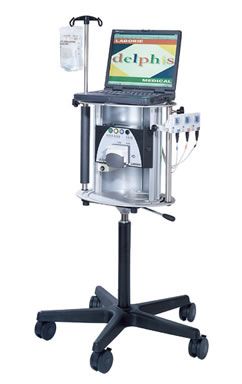Urodynamic Testing (Bladder Test)
If you have a problem with urine leakage or blocked urine flow, your doctor or nurse may be able to help. One of the tools they may use to evaluate the cause of your symptoms is urodynamic testing.
Several muscles, organs, and nerves are involved in collecting, storing, and releasing urine. The kidneys form urine by filtering wastes and extra water from the bloodstream. The ureters are tubes that carry urine from the kidneys to the bladder. Normally urine flows in one direction. If urine backs up toward the kidneys, infections and kidney damage can occur.
The bladder, a hollow muscular organ shaped like a balloon, sits in the pelvis and is held in place by ligaments attached to other organs and to the pelvic bones. The bladder stores urine until you are ready to empty it. It swells into a round shape when it is full and gets smaller as it empties. A healthy bladder can hold up to 16 ounces (2 cups) of urine comfortably. How frequently it fills depends on how much excess water your body is trying to get rid of.
The bladder opens into the urethra, the tube that allows urine to pass outside the body. Circular muscles called sphincters close tightly to keep urine from leaking. The involuntary leakage of urine is called incontinence.
Nerves in the bladder tell you when it is time to empty your bladder. When the bladder begins to fill with urine, you may notice a feeling that you need to urinate. The sensation becomes stronger as the bladder continues to fill and reaches its limit. At that point, nerves in the bladder send a message to the brain, and your urge to urinate intensifies.
When you are ready to urinate, the brain signals the sphincter muscles to relax. At the same time, the brain signals the bladder muscles to squeeze, thus allowing urine to flow through the urethra. When these signals occur in the correct order, normal urination occurs.
Problems in the urinary system can be caused by aging, illness, or injury. The muscles in and around your bladder and urethra tend to become weaker with age. Weak bladder muscles may result in your not being able to empty your bladder completely, leaving you at a higher risk for urinary tract infections. Weak muscles of the sphincters and pelvis can lead to urinary incontinence because the sphincter muscles cannot remain tight enough to hold urine in the bladder, or the bladder does not have enough support from the pelvic muscles to stay in its proper position.
Urodynamics is a study that assesses how the bladder and urethra are performing their job of storing and releasing urine. Urodynamic tests help your doctor or nurse see how well your bladder and sphincter muscles work and can help explain symptoms such as
- incontinence
- frequent urination
- sudden, strong urges to urinate
- problems starting a urine stream
- painful urination
- problems emptying your bladder completely
- recurrent urinary tract infections
Seeing Your Doctor or Nurse
The first step in solving a urinary problem is to talk with your doctor or nurse. He or she should ask you about your general medical history, including any major illnesses or surgeries. You should talk about the medicines you take, both prescription and nonprescription, because they might be part of the problem. You should talk about how much fluid you drink a day and whether you use alcohol or caffeine. Give as many details as you can about the problem and when it started. The doctor or nurse may ask you to keep a voiding diary, which is a record of fluid intake and trips to the bathroom, plus any episodes of leakage.
If leakage is the problem, the doctor or nurse may ask you to do a pad test. This test is a simple way to measure how much urine leaks out. You will be given a number of absorbent pads and plastic bags of a standard weight. You will be told to wear the pad for 1 or 2 hours while in the clinic or to wear a series of pads at home during a specific period of time. The pads are collected and sealed in a plastic bag. Your health care team will then weigh the bags to see how much urine has been caught in the pad. A simpler but less precise method is to change pads as often as you need to and keep track of how many pads you use in a day.
A physical exam will also be performed to rule out other causes of urinary problems. This exam usually includes an assessment of the nerves in the lower part of your body. It will also include a pelvic exam in women to assess the pelvic muscles and the other pelvic organs. In men, a rectal exam is given to assess the prostate. Your doctor will also want to check your urine for evidence of infection or blood.
Preparing for the Test
If the doctor or nurse recommends bladder testing, usually no special preparations are needed, but make sure you understand any instructions you do receive. Depending on the test, you may be asked to come with a full bladder or an empty one. Also, ask whether you should change your diet or skip your regular medicines and for how long.
Taking the Test
Any procedure designed to provide information about a bladder problem can be called a urodynamic test. The type of test you take depends on your problem. For an overview of urodynamic testing click here.
Most urodynamic testing focuses on the bladder’s ability to empty steadily and completely. It can also show whether the bladder is having abnormal contractions that cause leakage. Your doctor will want to know whether you have difficulty starting a urine stream, how hard you have to strain to maintain it, whether the stream is interrupted, and whether any urine is left in your bladder when you are done. The remaining urine is called the postvoid residual. Urodynamic tests can range from simple observation to precise measurement using sophisticated instruments.
Uroflowmetry (Measurement of Urine Speed and Volume) – A uroflow meter automatically measures the amount of urine and the flow rate—that is, how fast the urine comes out. You may be asked to urinate privately into a toilet that contains a collection device and scale. This equipment creates a graph that shows changes in flow rate from second to second so the doctor or nurse can see the peak flow rate and how many seconds it took to get there. Results of this test will be abnormal if the bladder muscle is weak or urine flow is obstructed.
Your doctor or nurse can also get some idea of your bladder function by using a stopwatch to time you as you urinate into a graduated container. The volume of urine is divided by the time to see what your average flow rate is. For example, 330 milliliters (mL) of urine in 30 seconds means that your average flow rate is 11 mL per second.
Measurement of Postvoid Residual – After you have finished, you may still have some urine, usually only an ounce or two, remaining in your bladder. To measure this postvoid residual, the doctor or nurse may use a catheter, a thin tube that can be gently glided into the urethra. He or she can also measure the postvoid residual with ultrasound equipment that uses harmless sound waves to create a picture of the bladder. A postvoid residual of more than 200 mL, about half a pint, is a clear sign of a problem. Even 100 mL, about half a cup, requires further evaluation. However, the amount of postvoid residual can be different each time you urinate.
Cystometry (Measurement of Bladder Pressure) – A cystometrogram (CMG) measures how much your bladder can hold, how much pressure builds up inside your bladder as it stores urine, and how full it is when you feel the urge to urinate. The doctor or nurse will use a catheter to empty your bladder completely. Then a special, smaller catheter will be placed in the bladder. This catheter has a pressure-measuring device called a manometer. Another catheter may be placed in the rectum to record pressure there as well. Your bladder will be filled slowly with warm water. During this time you will be asked how your bladder feels and when you feel the need to urinate. The volume of water and the bladder pressure will be recorded. You may be asked to cough or strain during this procedure. Involuntary bladder contractions can be identified.
Measurement of Leak Point Pressure – While your bladder is being filled for the CMG, it may suddenly contract and squeeze some water out without warning. The manometer will record the pressure at the point when the leakage occurred. This reading may provide information about the kind of bladder problem you have. You may also be asked to apply abdominal pressure to the bladder by coughing, shifting position, or trying to exhale while holding your nose and mouth. These actions help the doctor or nurse evaluate your sphincter muscles.
Pressure Flow Study – After the CMG, you will be asked to empty your bladder. The catheter can measure the bladder pressures required to urinate and the flow rate a given pressure generates. This pressure flow study helps to identify bladder outlet obstruction that men may experience with prostate enlargement. Bladder outlet obstruction is less common in women but can occur with a fallen bladder or rarely after a surgical procedure for urinary incontinence. Most catheters can be used for both CMG and pressure flow studies.
Electromyography (Measurement of Nerve Impulses) – If your doctor or nurse thinks that your urinary problem is related to nerve or muscle damage, you may be given an electromyography. This test measures the muscle activity in and around the urethral sphincter by using special sensors. The sensors are placed on the skin near the urethra and rectum or they are located on the urethral or rectal catheter. Muscle activity is recorded on a machine. The patterns of the impulses will show whether the messages sent to the bladder and urethra are coordinated correctly.
After the Test
You may have mild discomfort for a few hours after these tests when you urinate. Drinking an 8-ounce glass of water each half-hour for 2 hours should help. Ask your doctor whether you can take a warm bath. If not, you may be able to hold a warm, damp washcloth over the urethral opening to relieve the discomfort.
Your doctor may give you an antibiotic to take for 1 or 2 days to prevent an infection. If you have signs of infection—including pain, chills, or fever—call your doctor at once.

